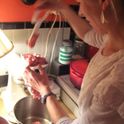A few mornings ago I sat in my office with an array of whiskey samples in front of me. They were all the same whiskey from our distillery—a bourbon mash aged in a mix of barrels previously used for port and for bourbon—and they had all aged the same amount of time in our barrel room. But each sample, each taken from a different barrel, tasted markedly different. I tasted, scribbled notes, and gradually decided which four barrels we would mix together to comprise the next release of our whiskey.
I think of this process as "blending" whiskey, but in the industry it’s called "vatting." Unless a whiskey is a single-barrel release, it is virtually always vatted. And yet "blended" is often a dirty word when associated with whiskey, denoting poor quality. So, what gives?
As with many things, “blended” whisky was historically pretty good, then earned its bad reputation legitimately through problems with quality. But it's since begun to transcend its reputation in practice, if not in our psyches. (As a side note, whether or not you put an "e" in whiskey depends on what country you’re in, and often varies based on which country’s whiskey you’re talking about.)
In the mid- to late 1800s in Scotland, blended whisky was developed to make a softer, more palatable alternative to the heavily-peated malt whiskies being made at the many tiny distilleries dotting the country. The blended whiskies combined malt whisky (distilled from malted barley) with gentler, smoother grain whiskies (made from any grain that isn’t malted barley). Thus was born the likes of Johnny Walker, a blended whisky that still lives and reigns today. But in more recent years, large quantities of high quality, long-aged single-malt whisky has started to become available, lifting single malt to the throne as king of whisky. At the same time, many blended whiskies have begun to rely more on lower and lower quality grain whisky, compromising the quality of the overall spirit.
Therein lies the rub: Blending is not inherently bad, in fact it has the potential to be very, very good, but any blend is really only going to be as good as the quality of the things you put into it. Some blended whiskies have returned to the approach of blending high-quality whiskies to create something different and more balanced than any of the individual original whiskies that go into the blend. Compass Box is a notable example of thoughtful blending.
Think of blending whisky like blending paint pigments. You’re making a painting of a stormy sea that’s boiling blue-green-grey. On your painter’s palette you have a nice brilliant green, a nice royal blue, and so on. None of these colors will evoke the sea in the way you want to, so you mix drops of them together to create a new color. The colors you choose to mix, as well as the proportion of each, will alter what the final color winds up being. And, if one or two of the paints you use are bad quality (maybe really clumpy or thin so they don’t give good coverage) this will make the final paint blend worse. However, if all the pigments you start with are nice, you can mix up precisely the blue-green-grey of the sea that you’re going for.
This is also the approach that has long been used in wine. It's true, these days, that single-varietal wines have become popular in a way they never have been before. We reach for the Cabernet Sauvignon, the Pinot Noir, or the Chardonnay instead of the “red blend” or “white blend” because an unspecified blend may sound nondescript. But many—even most—of the world’s truly great wines are blends.
Blending the wine from different grapes allows a winemaker to work toward a perfect marriage and balance of fruit, acidity, tannins, and alcohol to create a wine that can be more sparklingly complex than a wine made from a single-grape varietal. A red Bordeaux, for example is usually a blend of Cabernet Sauvignon, Merlot, Cabernet Franc, and sometimes other grapes as well. The Merlot’s plummy velvet softens the sometimes rigid structure and savory notes of Cabernet Franc. The Cabernet Sauvignon boosts the other two with its powerful body and complexity. And different estates in different years may make adjustments to their blends to create their own style and realize their own vision for what their wine should be.
Speaking of creating your style, many commercial winemakers also blend their wine to try to achieve consistency from year to year. When a brand has a specific taste that it knows its customers are looking for, the winemakers blend together wine from their different storage vessels and even from different years to try to create a consistent product.
And this brings us back to vatting with whiskey: For large whiskey distilleries with a signature flavor, the only way to achieve this flavor (when the fact of the matter is that every barrel of whiskey ages slightly differently from the next) is to mix together multiple barrels of whiskey. Even in single-malt Scotch, the word "single" in there means it is from a single distillery, but not from a single barrel or even distillation run. Your single malt will be a blend of multiple barrels with the goal of achieving the distiller’s vision of balance and complexity. And that brings us back to me, sitting with my samples. I chose barrel numbers 29, 31, 32, and 33. It’s going to be a lovely whiskey.
Fiveandspice, a.k.a. Emily Vikre, is a writer, self-described "food policy wonk," and co-founder of Vikre Distillery. She lives in Duluth, Minnesota. You can read more of her writing here.
What other boozy misconceptions need righting? Tell us about it in the comments.

On Black & Highly Flavored, co-hosts Derek Kirk and Tamara Celeste shine a light on the need-to-know movers and shakers of our food & beverage industry.
Listen Now



See what other Food52 readers are saying.